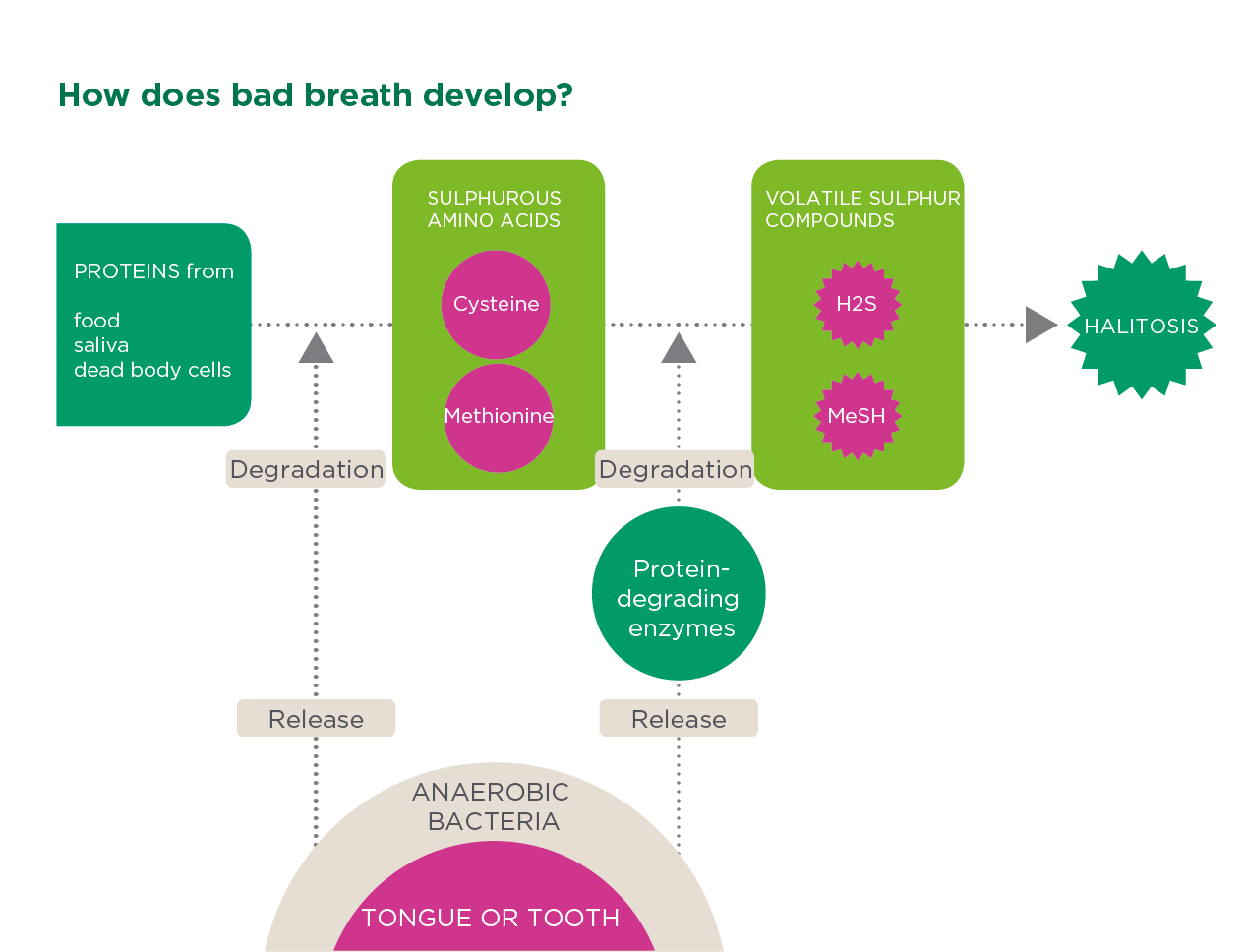
Halitosis (Bad Breath): Definition, Causes and Treatment
Halitosis (lat. Halitus: breath, haze) is a condition in which the breath has a particularly noticeable bad odour that emanates not only from the mouth, but also from the nasal cavity. In the literature, definitions include: "an oral health condition characterized by unpleasant odors emanating consistently from the oral cavity" [1] and "general term to describe any disagreeable odor of breath, regardless of its origin" [2].

Physiological and pathological halitosis
A distinction needs to be made between different types of halitosis.
True halitosis, in which bad breath is objectively shown to exist, is divided into physiological and pathological halitosis.
- Physiological halitosis is not caused by a specific disease but rather by factors related to the dorsal region of the tongue.
- Pathological halitosis on the other hand, is often caused by blood born and gastroesophageal diseases, pathological processes in the oral cavity, or dysfunction of the oral tissues.
Aydin & Harvey-Woodworth proposed a new classification of halitosis in 2014. They argued that many of the existing definitions were inadequate, ignoring the potential emanation of odors via the mouth and nose from the respiratory and gastroesophageal tracts, transfer of volatiles from blood to breath during alveolar gas exchange, and the self-perception of halitosis by the patient [3].
To varying degrees the breath always has odorant volatiles, originating orally or elsewhere. Aydin & Harvey-Woodworth set out to determine a clear boundary between normal, physiologic breath odor and, pathologic halitosis. They classified halitosis into 5 main types (Fig. below) representing different odor mechanisms, which may be present in any combination at any time.
Potentially, each type of pathologic halitosis (Type 1-5) is superimposed on physiologic odor (Type 0). At any given time, pathologic halitosis is the sum of the all these types sources, as well as their respective underlying physiologic contributions.
Pseudohalitosis and halitophobia
Pseudohalitosis occurs when bad breath is only perceived by the patient, but it is not measurable and is not noticed by others.
Halitophobia is an extreme form of pseudohalitosis. A patient suffering from halitophobia cannot be convinced that his bad breath is imaginary, even after extensive diagnostics. Halitophobia is classed as a psychological obsessive-compulsive disorder. A study by the University of Leuven showed that almost 16% of the 2'000 study participants suffered from pseudohalitosis or even halitophobia [4].

Prevalence of halitosis
Since information about the frequency of halitosis is subjectively biased, it is difficult to make a definitive statement about its actual prevalence.
Nevertheless, various studies indicate that halitosis seems to be a widespread condition: Seemann [5] found that halitosis occurred in approx. 25% of the world's population, regardless of cultural background. In one US study, as many as 43% of over-60s reported suffering from recurring halitosis [6] indicating that older people are more affected than younger people.
A very recent systematic review (2018) found the combined prevalence of halitosis to be 31,8% (95% CI 24,6-39,0%), indicating a roughly a third of the population suffers from this condition [7].
Causes of halitosis
The most common cause of halitosis has its origin in the oral cavity (93%) [8], in particular, the metabolic activity of oral bacteria is a major cause, whereby gas-emitting bacteria on the tongue and below the gum line are largely responsible for the condition [9].
A few elegant experiments confirm this. In-vitro studies of pure or mixed cultures of saliva, plaque or tongue plaque, indicate that many oral bacteria produce volatile sulphur compounds (VSC), short chain fatty acids and cadaverine - all components that are found in exhaled air and which play a part in its odour [10]. The biofilm on the tongue in particular harbours many such micro-organisms, which convert the various food substrates (such as amino acids) into highly odorous volatile compounds [11].
Tongue plaque can therefore be counted among the most common causes of halitosis (51%), while patients with deep periodontal pockets (> 4mm) have more tongue coating, and are therefore at a greater danger of developing halitosis.
Further oral causes of halitosis include periodontitis (17%), gingivitis (15%) or other oral diseases (17%), while causes in the ENT and gastrointestinal tract are responsible for only 7% of cases [12].
In summary, changes in oral ecology have clear repercussions in the form of halitosis, while conditions related to poor dental hygiene such as tongue plaque, gingivitis and periodontitis are clearly responsible for some 83% of cases.
Halitosis is therefore undoubtedly a matter for the dental practice.
References:
[5] [10] Seemann R: Halitosis – ein multikausales Problem. Zahnärztliche Mitteilungen 89 (1999), 1794-1796.
[6] Loesche WJ, Grossman N, Dominguez L, Schork MA. Oral malodour in the elderly. In: Van Steenberghe D, Rosenberg M (Eds.) Bad Breath. A multidisciplinary approach. Leuven: University Press 1996.
[11] Tonzetich, Joseph. Production and origin of oral malodour: a review of mechanisms and methods of analysis. Journal of periodontology 48.1 (1977): 13-20.



